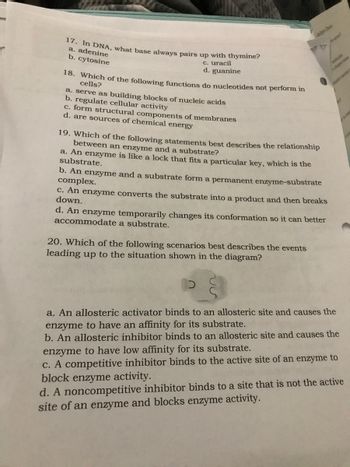
Human Anatomy & Physiology (11th Edition)
11th Edition
ISBN: 9780134580999
Author: Elaine N. Marieb, Katja N. Hoehn
Publisher: PEARSON
expand_more
expand_more
format_list_bulleted
Concept explainers
Question
thumb_up100%
Please help me understand and answer the following.

Transcribed Image Text:17. In DNA, what base always pairs up with thymine?
a. adenine
c. uracil
d. guanine
b. cytosine
18. Which of the following functions do nucleotides not perform in
cells?
a. serve as building blocks of nucleic acids
b. regulate cellular activity
c. form structural components of membranes
d. are sources of chemical energy
19. Which of the following statements best describes the relationship
between an enzyme and a substrate?
a. An enzyme is like a lock that fits a particular key, which is the
substrate.
b. An enzyme and a substrate form a permanent enzyme-substrate
complex.
c. An enzyme converts the substrate into a product and then breaks
down.
d. An enzyme temporarily changes its conformation so it can better
accommodate a substrate.
20. Which of the following scenarios best describes the events
leading up to the situation shown in the diagram?
malls
charged as
a. An allosteric activator binds to an allosteric site and causes the
enzyme to have an affinity for its substrate.
b. An allosteric inhibitor binds to an allosteric site and causes the
enzyme to have low affinity for its substrate.
c. A competitive inhibitor binds to the active site of an enzyme to
block enzyme activity.
d. A noncompetitive inhibitor binds to a site that is not the active
site of an enzyme and blocks enzyme activity.
Expert Solution
arrow_forward
Step 1
DNA is a double-stranded molecule that has a long chain of nucleotides. RNA is a single-stranded molecule which has a shorter chain of nucleotides.
Step by stepSolved in 5 steps

Knowledge Booster
Learn more about
Need a deep-dive on the concept behind this application? Look no further. Learn more about this topic, biology and related others by exploring similar questions and additional content below.Similar questions
- Post a short summary about the assigned video posted below https://www.youtube.com/watch?v=5-bN7qB_kckarrow_forwardBriefly write about Oral Contraceptives disorder and its management? Please answer at your own easy words. Please add some image, pictures or diagrams regarding the topic. I will rate you positive if you do so. Thank you.arrow_forwardPlease help me answer these! Please show how you got them. Thank you.arrow_forward
- I want answer of question no 2 to question no 12 Please give me Thank you!arrow_forwardHello, Can you please help me to answer next question abaut the case? Case: Mr. Hollon is a retired 76-year-old male who spent his entire working career as a fire fighter. He has a 22-year history of type 2 diabetes; he also has hypertension and emphysema. He is an active smoker (52-pack year smoking history), although he has attempted to stop smoking on several occasions. He wears a hearing aid in each ear because of hearing loss as a result of working around machinery for several years. Thinking in sensory perception: List three clinical manifestations that the cues suggest need to have further investigation or assessment. Thank you in advance!arrow_forwardHi, can you please help me label this? Thank youarrow_forward
- PLEASE ANSWER the questions correlty and please answer all the questions with what it regards in saying exactly, please and thank you take your time. Ive read the guide lines and honor code that i can have up to Submit only one question at a time under the appropriate subject. A question can have up to 3 subparts (i.e. part a, b, and c). If you dont belive me here is the link of barthleby saying exactly that thanks: https://bartleby.zendesk.com/hc/en-us/articles/360017462394-How-can-I-ensure-my-questions-get-answered-as-quickly-as-possible-arrow_forwardHi there! Would you be able to assist with this question?arrow_forwardPlease answer very soonarrow_forward
arrow_back_ios
arrow_forward_ios
Recommended textbooks for you
 Human Anatomy & Physiology (11th Edition)BiologyISBN:9780134580999Author:Elaine N. Marieb, Katja N. HoehnPublisher:PEARSON
Human Anatomy & Physiology (11th Edition)BiologyISBN:9780134580999Author:Elaine N. Marieb, Katja N. HoehnPublisher:PEARSON Biology 2eBiologyISBN:9781947172517Author:Matthew Douglas, Jung Choi, Mary Ann ClarkPublisher:OpenStax
Biology 2eBiologyISBN:9781947172517Author:Matthew Douglas, Jung Choi, Mary Ann ClarkPublisher:OpenStax Anatomy & PhysiologyBiologyISBN:9781259398629Author:McKinley, Michael P., O'loughlin, Valerie Dean, Bidle, Theresa StouterPublisher:Mcgraw Hill Education,
Anatomy & PhysiologyBiologyISBN:9781259398629Author:McKinley, Michael P., O'loughlin, Valerie Dean, Bidle, Theresa StouterPublisher:Mcgraw Hill Education, Molecular Biology of the Cell (Sixth Edition)BiologyISBN:9780815344322Author:Bruce Alberts, Alexander D. Johnson, Julian Lewis, David Morgan, Martin Raff, Keith Roberts, Peter WalterPublisher:W. W. Norton & Company
Molecular Biology of the Cell (Sixth Edition)BiologyISBN:9780815344322Author:Bruce Alberts, Alexander D. Johnson, Julian Lewis, David Morgan, Martin Raff, Keith Roberts, Peter WalterPublisher:W. W. Norton & Company Laboratory Manual For Human Anatomy & PhysiologyBiologyISBN:9781260159363Author:Martin, Terry R., Prentice-craver, CynthiaPublisher:McGraw-Hill Publishing Co.
Laboratory Manual For Human Anatomy & PhysiologyBiologyISBN:9781260159363Author:Martin, Terry R., Prentice-craver, CynthiaPublisher:McGraw-Hill Publishing Co. Inquiry Into Life (16th Edition)BiologyISBN:9781260231700Author:Sylvia S. Mader, Michael WindelspechtPublisher:McGraw Hill Education
Inquiry Into Life (16th Edition)BiologyISBN:9781260231700Author:Sylvia S. Mader, Michael WindelspechtPublisher:McGraw Hill Education

Human Anatomy & Physiology (11th Edition)
Biology
ISBN:9780134580999
Author:Elaine N. Marieb, Katja N. Hoehn
Publisher:PEARSON

Biology 2e
Biology
ISBN:9781947172517
Author:Matthew Douglas, Jung Choi, Mary Ann Clark
Publisher:OpenStax

Anatomy & Physiology
Biology
ISBN:9781259398629
Author:McKinley, Michael P., O'loughlin, Valerie Dean, Bidle, Theresa Stouter
Publisher:Mcgraw Hill Education,

Molecular Biology of the Cell (Sixth Edition)
Biology
ISBN:9780815344322
Author:Bruce Alberts, Alexander D. Johnson, Julian Lewis, David Morgan, Martin Raff, Keith Roberts, Peter Walter
Publisher:W. W. Norton & Company

Laboratory Manual For Human Anatomy & Physiology
Biology
ISBN:9781260159363
Author:Martin, Terry R., Prentice-craver, Cynthia
Publisher:McGraw-Hill Publishing Co.

Inquiry Into Life (16th Edition)
Biology
ISBN:9781260231700
Author:Sylvia S. Mader, Michael Windelspecht
Publisher:McGraw Hill Education